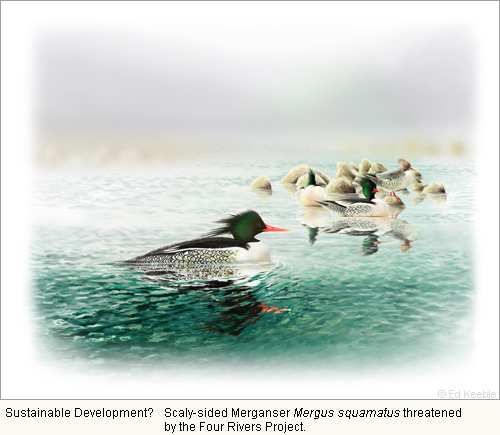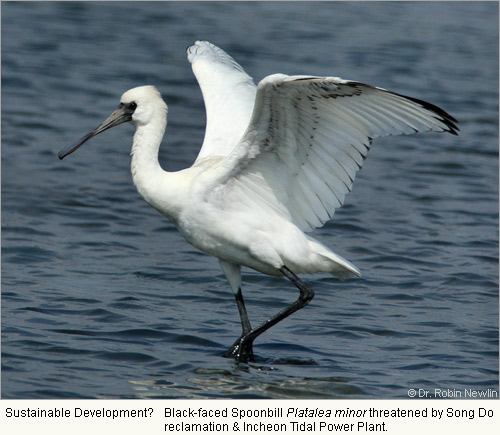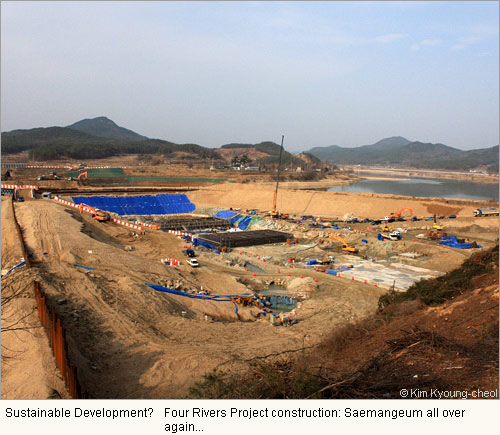A survey in 2009 confirmed that 80% of the population in the Republic of Korea believes that "in planning development projects, environmental conservation should take precedence over economic gains" (Hwang 2009). Birds Korea is proud to be part of this 80%. With our membership we strive for sustainable development, as defined by the United Nations and the Millennium Development Goals. We work honestly, for the conservation of birds, habitats, culture and the peace of mind that comes from feeling part of the natural world.
But these are exasperating and contradictory times.
60 trillion Won ($52 billion) of state-initiated construction projects are now planned for 2010 (Korea Times January 29 2010), adding to the excesses of the past few years. 2010 sees planned resort developments (as on Gageo Island), more huge buildings and new roads, railway projects and trails through sensitive habitats (as at Suncheon Bay Ramsar site), and a growing number of massive developments (“mega-projects”). Many of these mega-projects are labelled as “green”, even though the impacts they have on biodiversity, on nature, landscapes and culture, are enormous. Our own Preliminary Report, for example, suggests that approximately 50 species of bird (more than one in ten recorded regularly in Korea), one-third of all waterbirds that winter in the ROK, and several globally-threatened species, will be negatively impacted by the Four Rivers Project
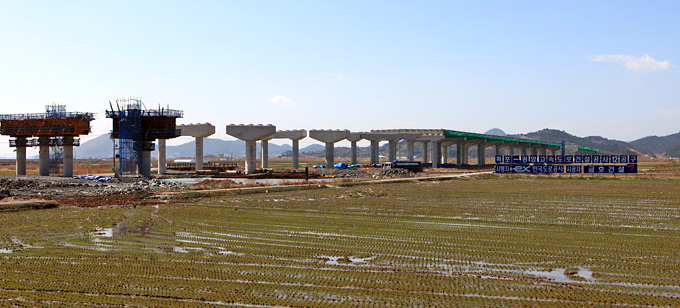
How can this happen?
Our nation, by being a contracting party to the intergovernmental Ramsar Convention has agreed to conserve all wetlands that are “internationally important” as defined by Ramsar criteria.
Our nation has also agreed to conserve populations of migratory waterbirds. It has done so through national laws, through joining the Ramsar Convention and the Convention on Biological Diversity, and through signing bilateral agreements.
Our nation, as a member of the United Nations, also supports the Millennium Development Goals. The Millennium Development Goals make clear that solving one environment problem (such as energy use) should not be at the cost of creating another problem (such as causing biodiversity loss). Instead, genuinely sustainable development finds ways to solve problems simultaneously, to create win-win situations that benefit both the nation and the planet that all of us share.
These are the commitments to conservation that the nation has willingly, publicly and formally accepted on behalf of and for the benefit of us all. These are the commitments and the promises that Birds Korea and many others are working to protect. Conserving birds and their habitats means conserving other species and the ecosystems they depend on. In turn, conserving the most bio-diverse ecosystems provides multiple benefits to people, including healthy water, healthy food, a healthy climate and beautiful places of culture, for recreation and education.
It is clear that the majority of people here in the ROK, indeed 80% of us, and many people around the world support policies that work for genuinely sustainable development.
So, what are some of the mega-projects that are claiming to be sustainable and green?
Saemangeum
During the past decade, as a growing number of people started to express concern about the anticipated global impacts of the massive 40,100 ha Saemangeum reclamation on migratory birds, the response by proponents was not to cancel or scale the project down. Rather, they promised that the destruction of tidal-flats and sea shallows to create rice-fields would actually be “environmentally-friendly”, and would even lead to an increase in waterbirds (Birds Korea 2003).
By the passing of special laws, the primary end-use of Saemangeum has become industrial. Yet the proponents continue to sell this massive “green and gold” reclamation both at home and overseas as an eco-friendly project, creating wetlands and eco-parks, worthy of investment. The repackaging has convinced at least some investors and media.
This greenwash effort at Saemangeum, however, undermines calls to restore tidal-flow at Saemangeum. It stimulates calls for further reclamation in the ROK and the Yellow Sea.
While some may argue that money should not be wasted on restoration, it is important to remember that the restoration of tidal-flow at Saemangeum would cost far less than the Four Rivers Project, and provide more obvious benefits. Moreover, the huge costs of the Saemangeum reclamation are still increasing: economically, culturally and for biodiversity. The Saemangeum Shorebird Monitoring Program (conducted by Birds Korea and the Australasian Wader Studies Group) confirms that the massive loss of habitat at Saemangeum by 2008 had already contributed to the rapid global decline of the now Critically Endangered Spoon-billed Sandpiper, and the “loss” of 20% of the world’s Great Knot (Moores et al. 2008). And how much more will all the new inner sea-walls, roads and water purification plants cost?
It is never too late to do the right thing, especially when reclamation at Saemangeum and elsewhere in the Yellow Sea is resulting in massive and measurable declines in a broad range of shorebird species and when the sea’s fisheries are in such decline. How much is biodiversity, how much are the fisheries, and how much is the nation’s word worth?
Despite its clarity, the science measuring the costs of reclamation is still ignored by reclamation proponents, at Saemangeum and elsewhere, and by the proponents of other mega-projects. The prolonged domestic and international criticism of the Saemangeum reclamation did have results, however.
The ROK formally announced in 2008 that “intertidal mudflats should be preserved and that no large-scale reclamation projects are now being approved in the Republic of Korea” (Ramsar Resolution X.22).
The nation also elected to host a number of high-profile international environmental conferences (including the Ramsar Convention conference, the IUCN World Congress and meetings of the East Asia-Australasia Flyway Partnership). And the nation has embarked on a new green direction with the New Green Deal and the emphasis on Green Growth. But with all the words, have the actual policies after close of the Saemangeum seawall in 2006 actually changed?
Song Do & the Incheon Tidal Power Plant
In March 2009, only five months after the public promise of Ramsar Resolution X.22, the large-scale reclamation of the last remaining area of internationally important tidal-flat at Song Do in Incheon was approved (Birds Korea 2009).
This year, up to 20 US-based universities have been in talks, apparently to receive funds from the ROK to establish overseas campuses on very recently-reclaimed land in the same Song Do “Eco-city” (e.g. "Danney 2010): more investment in reclamation. The threatened tidal-flat at Song Do, supporting 13 species of waterbirds in Ramsar-defined internationally important concentrations, and the proposed Song Do Global University Campus, ironically both lie within view of the newly-established office of the East Asian-Australasian Flyway Partnership. This Partnership is working hard for the conservation of migratory birds and their habitats. Its office is now funded by Incheon City, the main reclamation proponent.
Incheon City is also proposing the world’s largest tidal power plant (one of several now planned), requiring the construction of several massive concrete dykes and the impoundment of 15,700 ha of Ramsar-defined internationally important inter-tidal mudflats lying between Ganghwa Island and Yeongjong, next to the nation’s main international airport. This stunningly beautiful and natural wetland is one of the first sights to greet home-comers and visitors to Korea alike. These natural tidal-flats sequester carbon (a vital role in controlling climate change), provide a place of peace and recreation for people, and they support the globally Endangered Red-crowned Crane Grus japonensis in winter, and large numbers of the globally Endangered Black-faced Spoonbill Platelea minor and Globally Vulnerable Chinese Egret Egretta eulophotes in summer. These three species are National Natural Monuments. Should this internationally important wetland be destroyed in order to make “environmentally friendly” energy for Incheon City?
There are already different tidal power plant designs that are believed to cause many fewer impacts on biodiversity (e.g. as reported in popular media by Cho 2009 and Strain 2010). However, an initial agreement has been struck with GS Engineering & Construction, and construction of the dykes is planned to start in the second half of 2011 (Anon 2010). Most, if not all, developed nations have laws that would prevent such a project from even proceeding.
The Four Rivers Project
On a narrow peninsula surrounded on three sides by sea, the proposed Korean Grand Canal offered the peculiar promise of ships sailing across mountains through the canalisation of the nation’s main rivers. After a growing wave of opposition, and as the ROK prepared to host the 2008 Ramsar Convention conference (Ramsar COP10), the “Central government took the bold and highly welcome step of suspending the Korean Grand Canal Project ...” (Moores 2008).
A little over a month after Ramsar COP10, however, the Grand Canal was replaced by the even grander “Four Main Rivers Restoration Project”, now lying at the heart of the new Green Growth strategy. Coming with the price-tag of a minimum 19 Billion USD (Science magazine March 26 2010), it has the stated aims of reducing flooding, securing more water reserves and puzzlingly (considering the emphasis on construction), helping the nation to combat human-induced climate change.
Its packaging as a restoration project had until recently helped it to escape much international review or criticism, and has likely helped persuade many (including decision-makers) to believe in its green credentials. All the same, the Four Rivers Project is still opposed by 70% of the population in the ROK (Doh 2010), and international awareness is growing, especially following an article in Reuters and more detailed coverage by the US-based Science magazine (March 26th), under the heading of “Restoration or Devastation?”.
While there is an undoubted need to restore the nation’s already degraded rivers, floodplain wetlands and estuaries and to curb fast-growing rates of greenhouse gas emission, this Four Rivers Project is clearly not “restoration” as popularly understood or as described in the conservation and scientific literature. Rather it is the latest in a line of mega-projects that includes Saemangeum, Song Do “Eco-city”, and the proposed Incheon Tidal Power Plant.
With an environmental impact assessment (EIA) that was conducted in only three or four months, the Four Rivers Project was launched in November 2009. As presently proposed, the first phase alone entails the deep-dredging of almost 700 km of shallow river, the construction of 16 new dams, the re-construction of two estuarine barrages, and the building of over 1700 km of bicycle road along four of the nation’s largest rivers (The Han, the Nakdong, the Geum and the Yeongsan). This phase will lead to habitat degradation of at least one Ramsar site and probably eight Important Bird Areas, and increase disturbance greatly in many presently wildlife-rich areas, including stretches of river used by the very shy Scaly-sided Merganser. The second (simultaneous) phase adds five more new dams to the tributaries of the main rivers, and the “refurbishment” of over 2,000 km of streams and small rivers.
Both phases one and two will be completed by 2012 – the year in which the ROK hosts the next IUCN World Congress.
The third phase, as part of the subsequent Master Plan for Rivers (to be released this year), then aims for the “fuller utilisation” of a further 13,000 km of stream and river nationwide (MLTM, 2009). If conducted with contemporary river-engineering methods (see e.g. Hadley 2007) this phase too will cause much further loss of biodiversity nationwide.
As part of this mega-project, numerous eco-parks and “eco-rivers” will be built. It is unclear what form these will take. However, existing eco-parks typically include large buildings, new roads and ornamental shrubbery – requiring in Suncheon Bay Ramsar site for example, the concreting and grassing-over of several rice-fields which had been used by wintering Hooded Cranes. The term “eco-river” appears to have been newly-coined. One formal document reveals, however, that eco-rivers are to be used for planting and harvesting of trees for biofuel – part of the national strategy to reduce greenhouse gas emissions.
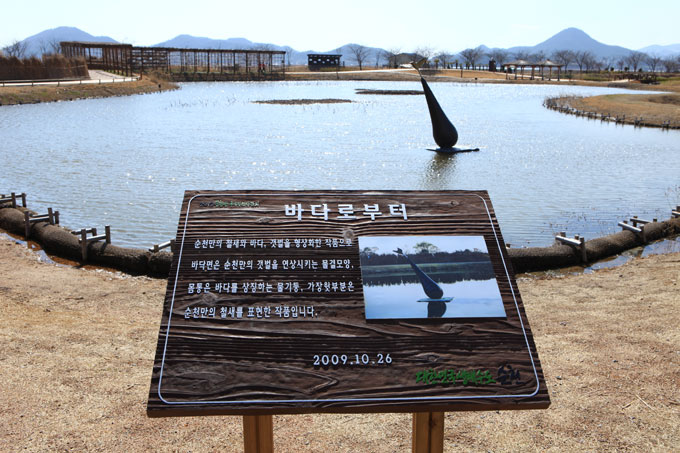
The Four Rivers Project has since its inception been sold as a “green” project. Ads in media and display panels set up in train and ferry stations (advertising already projected to cost 14.5 billion Korean Won by the end of 2010: Doh 2010) repeatedly depict green-lined rivers, with deep blue waters, often over-flown by skeins of Red-crowned Cranes. This is an appealing fantasy, but it is not scientifically credible, and it has not persuaded the majority of people. Opponents, in the ROK, include 70% of people, all well-known environmental NGOs, the 2800-strong “Professors’ Organisation for Movement Against Korean Grand Canal”, and overseas, an increasing number of specialist organisations.
In response, the ministry behind the project, the Ministry of Land, Transport and Maritime Affairs (MLTM), asserts that all those opposing the Four Rivers Project simply do not understand about rivers or the environment. The same kinds of things were said about those opposing the reclamation of Saemangeum. Conservation organisations, including Birds Korea, however, predicted the anticipated impacts of the Saemangeum reclamation clearly, honestly and accurately. We are again anticipating major negative impacts on the nation’s biodiversity if the Four Rivers goes ahead as presently proposed.
Those in charge of the Four Rivers appear unconcerned. The MLTM admits it has “no information” on the Scaly-sided Merganser (Oliver 2009), a globally Endangered species that is ecologically dependent upon shallow rivers, including the Four Rivers. This statement was even made after the EIA for the Four Rivers Project had been completed. As the species is recorded regularly by the Ministry of Environment’s winter bird census (MOE Census), are those in charge of the project simply choosing to ignore the Ministry of Environment’s own data?
Either way, the MLTM is still selling the Four Rivers as a restoration project, concluding in January that “Domestically assessment has been negative, but foreigners have been very positive.” (Doh 2010).
It is for reasons such as these that court-cases have been launched aiming to stop the Four Rivers Project, and why we are asking conservation organisations overseas to add their voices of concern to those in Korea. Let reason triumph, and let money already allocated for the Four Rivers be invested instead in genuine restoration and conservation of rivers, wetlands, of Saemangeum, of the cultural and biodiversity heritage – a win-win outcome.
To help inform civil society and decision-makers to this end, we therefore published our bilingual preliminary report on the “Anticipated Impacts of the Four Rivers Project on Waterbirds” in March 2010, providing drafts to government departments (including the MLTM and the Ministry of Environment), other NGOs and wetland experts for fact-checking and input. This preliminary report fills several important information gaps, through providing background information on the nation’s rivers and waterbirds, and by describing some of the more obvious threats to waterbirds through e.g. (1) reduced flood-pulse, (2) loss of shallow river habitat, (3) increased degradation and reduced opportunity for the restoration of estuaries, and (4) increase in disturbance.
As there is no comprehensive waterbird monitoring program in place, the report is based largely on data from an annual one-day MOE Census, in addition to extensive review of scientific literature. Species and some of the sites that are likely to be affected by phase one of the Four Rivers Project are identified, including 48 out of >140 sites now covered by the MOE Census. We believe that, if treated with due caution, data from these 48 sites can provide useful insight into the numbers of waterbirds and the species likely to be most affected, and in future years should enable some of the impacts, negative and positive, of the Four Rivers Project to be monitored and assessed with greater confidence.
It is clear already though: unsustainable mega-projects like these devastate the natural resource base and lead to the loss of ecosystem services. The lack of best-practice EIA and concern for biodiversity that presently underlie much of the development in the ROK is driving species’ declines, preventing fulfilment of existing conservation obligations, and eroding trust – to the cost of the national image. Already our nation's global ranking in the independent global Environmental Performance Index has plunged - from 51st place in 2008 to 94th place at the beginning of 2010. In the same index, our nation is also ranked 147th out of 163 countries for efforts to reduce greenhouse gas emissions. (Korea Times January 29 2010).
The green packaging is fooling fewer and fewer people. Unsustainable development is losing the confidence and the potential investments of ethical investors. Genuinely sustainable development, in line with the Millennium Development Goals and existing conservation obligations, is urgently needed, in order to conserve key sites and species, to restore degraded ecosystems, and to conserve the beauty and culture of the nation. By protecting and cherishing the best of Korea, the nation will win more overseas investment, and help to strengthen the economy, the national brand and the nation as a whole.
We need less doublespeak and more conservation. The nation needs to win-win, instead of to lose-lose.
References
- Anon. (2010). GS Engineering to build world’s largest tidal power plant in South Korea. Alexander’s Gas & Oil Connection, January 10th 2010. Accessed in March 2010 online at: http://www.gasandoil.com/goc/company/cns100937.htm
- Birds Korea. (2003). The Ministry of Agriculture and Forestry’s Defence of the Saemangeum Reclamation: Credible Science of Wishful Thinking? An independent Birds Korea Report, September 2003. Accessed in March 2010 online at: http://www.birdskorea.org/Habitats/Wetlands/Saemangeum/BK-HA-Saemangeum-MAFrebuttal.shtml
- Birds Korea. (2009). Large-scale Reclamation of Song Do Tidal-flat Approved. March 24th, 2009. Accessed in March 2010 online at: http://www.birdskorea.org/Habitats/Wetlands/Songdo/BK-HA-Songdo-Tidal-flat-reclamation-2009-03.shtml
- Cho C-U. (2009). Green Growth: Korea’s New Strategy (62). Tidal power leads Korea’s green energy drive. Daum News, July 2009. Accessed in March 2010 online at: http://media.daum.net/foreign/englishnews/view.html?cateclass=1047&newsclass=20090727064024478&p=koreaherald
- Danney, M. (2010). South Korea Satellite Campus Still in the Works. Stony Brook Independent. February 12th, 2010. Accessed in March 2010 online at: http://www.sbindependent.org/node/3838
- Do J-H. (2010). Foreign NGOs Brings 4-Rivers Plan Positive Spin. The Korea Times, February 9th 2010. Accessed in March 2010 online at: http://www.koreatimes.co.kr/www/news/nation/2010/02/113_60590.html
- Gosbell L. & Clemens R. (2006). Population Monitoring in Australia: Some Insights after 25 Years and Future Directions. Stilt 50: 162-175. Published by the Australasian Wader Studies Group.
- Hadley, J. 2007. Osaek Creek Construction Work 2007.06.23. Accessed March 2010, online at: http://www.factplusfancy.com/pbw/kr/11/Osaek_Creek_Construction_Work_2007_06_23
- Hwang Ah-Ran. (2009). Ideological differences divide generations. No. 9, Series on Social Cohesion. The Korea Herald, August 26th, 2009. Accessed online in March 2010 at: http://www.koreaherald.co.kr/NEWKHSITE/data/html_dir/2009/08/26/200908260078.asp
- Inglis T. & D. Rogers. (2010). Tidal Flats Turned into Fatal Shores. Ethical Investor. March 2010. Issue 90. Pp.36-38.
- Kim S-H. & Moon G-L. (2009). Tidal plant to power Incheon. Joongang Daily Newspaper, July 14th, 2009. Accessed in March 2010, online at:http://joongangdaily.joins.com/article/view.asp?aclass=2907377. 2009. Tidal plant to power Incheon.
- Lee K-M. (2009). Saemangeum Gunsan Free Economic Zone Focuses on Renewable Energy, Parts & Materials. November 25, 2009. Korea IT Times. Accessed in March 2010 online at: http://www.koreaittimes.com/story/5896/sgfez-focuses-renewable-energy-parts-materials
- MLTM (2009). Ministry of Land, Transport and Maritime Affairs. Four Rivers Masterplan, 410 pages online (in Korean). Accessed on February 15, 2010 at: http://www.mltm.go.kr/ebook/4river_masterplan/EBook.htm http://www.mltm.go.kr/upload/main/4대강마스터플랜.pdf
- MOE. (2008), (2009). Ministry of Environment Winter Bird Census Report 2008; 2009. National Institute of Biological Resources. (in Korean)
- MOE. (2004), (2005), (2006), (2007). Ministry of Environment. National Institute of Environmental Research. Winter Bird Census Report. 1999-2004; 2005; 2006; 2007. (in Korean)
- Moores N. (2008). The Korean Grand Canal: another huge threat to the region’s wetlands and waterbirds. BirdingASIA 10 (2008): 48–53.
- Moores N., Kim A., Park M-N., Kim S-A. (2010). The Anticipated Impacts of the Four Rivers Project (Republic of Korea) on Waterbirds. Birds Korea Preliminary Report. Birds Korea publication, Busan.
- Moores N., Rogers D., Kim R-H., Hassell C., Gosbell K., Kim S-A & Park M-N. (2008). The 2006-2008 Saemangeum Shorebird Monitoring Program Report. Birds Korea publication, Busan.
- Oliver C. (2009). South Korea: New development bites the hand that feeds eco-tourism Financial Times. September 21 2009
- Peng B., Chen W. & Hong H. (2010). Integrating ecological damages into the user charge for land reclamation: a case study of Xiamen, China. Stoch Enviorn Res Risk Assess. Spring-Verlag 2010.
- Strain, A. (2010). Marine tidal power generating clean electicity. BBC News Channel, March 15 2010. Accessed online at: http://news.bbc.co.uk/2/hi/uk_news/northern_ireland/8569006.stm
see: (Korea's) Falling Environmental Ranking
Korea Times January 29th 2010
http://www.koreatimes.co.kr/www/news/opinon/2010/01/137_59951.html




